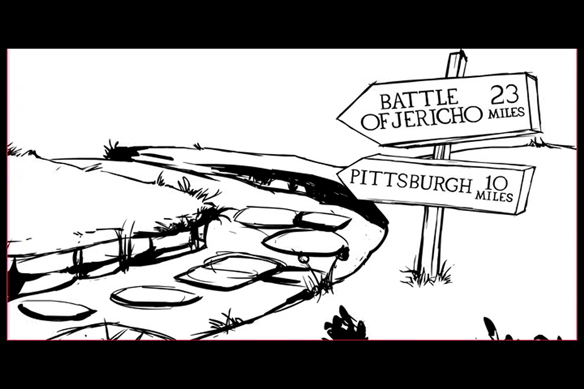

What is the plot of CowJews and Indians?
It starts very simply. My parents lost their property in Germany to the Nazis. They received reparations in 1951. I think to myself: why should we accept the reparations model? Why don’t I return the reparations (in today’s money), get the property back, and charge the Germans back rent?
I go to Germany to get our home back.


And then I realize I’m a hypocrite. Here I am in Germany complaining about the property taken away from my ancestors, when, in America, I’m living on and profiting from the land taken away from the ancestors of the Native Americans.


The Assigned Claim
I have a thought. If the Germans owe me for 65 years worth of back rent—and I owe the Native Americans for 65 years worth of back rent—why don’t I let the Native Americans collect directly from the Germans? Cut out the middleman!
I find four Native Americans, three from reservations, who go to Germany to get our home back and execute “the assigned–claim collection strategy.”



The Discovery
In the process, I get two new ideas.
The first idea is a solution to the Native American dispossession, a solution that has not been proposed in 500 years, a solution shockingly late in arrival. It’s strange that nobody thought of it.
The second idea involves an image. I will be purposefully vague here so I don’t ruin the film for you.
And that new meaning—the reminding power of that stimulating, ubiquitous, new analogy— provides an unexpected way of bringing my first idea to the public.
You shouldn’t be surprised by my discovery of this analogy. Why? Because, since 1989, I have been the Founder and Chief Analogist of the world’s only analogy service—the AAA Analogy Service Corporation. My service: You tell me your personal, corporate, artistic or scientific idea—and I’ll tell you what it reminds me of. I’ll tell you what it’s like. My corporate slogan is, “We Know What It’s Like.”
(The ganze Megillah begins here)
Product Safety—Is This Film Fit for Your Congregation or Readers?
First, some facts to consider when weighing the moral question of whether to announce this film to your congregation or readers.
Fact number one: The Ten Commandments ask us to not murder. The Creator goes out of His Way to mention it. One interpretation of that commandment: If we behave in a way that causes stress for people—the stress will shave a few seconds off the victim’s life—and to the extent that we reduce the victim’s lifespan, we have killed him/her—at least enough for a Jew, subtle enough to connect the dots, to make atonement. It can be argued—If we haven’t taken the entire remainder of the victim’s life away, we’ve taken SOME of the remainder of their life away. Am I making a fuss out of NOTHING?
Fact number two: We also know from experiments on laboratory mice that we can stress mice not only with extreme cold or heat or by depriving them of food or water, but also by—yes!—subjecting the mice to boredom.
The Moral Question: Can Murder Have Homeopathic Dosage Levels?
Keeping these two thoughts in mind, any spiritual leader is morally obligated to ask himself/herself the following question: If I were to put this announcement of “CowJews and Indians” in the synagogue newsletter or Jewish newspaper (for Jews that can’t find an L.A. Times), is it possible that I am encouraging my congregation or readers to go to a movie that might have boring moments—and therefore they will be stressed—and therefore their life will be shortened—and now, therefore, I’ll be an accomplice to murdering Jews? Will I be a Hitler? Should I, instead, preview a DVD of the film for the purpose of insuring product-safety?
These are the right (moral) questions to be asking. Let me answer these questions this way. One test audience member, who happens to be a film reviewer, called the film, “Borat meets Michael Moore.” Another test audience member said, “My voice was hoarse from laughing…it’s as serious as anything out there…a deadly combination…and I don’t like watching documentaries.”
 For those synagogues and Jewish reporters (frequently atheists with G-d-given talent) who want to just recklessly take a gamble and include this letter in the synagogue newsletter without the prudence to even preview the film—okay, not everyone takes the Ten Commandments that seriously.
For those synagogues and Jewish reporters (frequently atheists with G-d-given talent) who want to just recklessly take a gamble and include this letter in the synagogue newsletter without the prudence to even preview the film—okay, not everyone takes the Ten Commandments that seriously.
Jews (Including Even Conservative and Reform)—and Anyone Else—May Call Me
If you’re Orthodox—or even Conservative—you can call and argue with me for any reason at my home: 1-641–469–3338, or Skype me at chiefanalogist.
If you’re Reform, you should note that my cousin is Rabbi Dr. Julian Morgenstern, z”l, President Emeritus of Hebrew Union College (but we don’t speak about the Reform side of the family. My mother, z”l, was so religious she made Moses look like a goy.)
Okay, another joke at the expense of the Reform. (Reform Jews can call me if their Rabbi permits it. Whatever she says, goes.)
If you’re Chabad, you’ll probably also call me to find out if I put on Tefillin today.
Reporters
If you’re a reporter, you should feel slightly annoyed that I still think I’m just in the middle of a press release. Hasn’t the press release ended long ago? The investor has forced me to tell you, “It’s a good story. Your readers will talk about it. I do interviews. I have more images.” Me? I don’t talk like that.
Christians
If you’re a Christian, if such a thing ever happened to you, you’ll see the film as an allegory or a parable. What more can you ask for?
Polytheists
If you’re a polytheist, you’d hate to be in the position of rejecting someone else’s god—and then find out that the god you rejected was actually one of YOUR OWN gods. There are so many gods—who can keep track of which god belongs to whom? You’re probably religiously tolerant only to save yourself from this type of possible embarrassment.
Native Americans
If you’re Native American, allow me to recall a conversation with Tekahnawiiaks (the Mohawk nationalist in the film):
Me: [Marc Halberstadt] “Tekahnawiiaks, do you think Indians will like CowJews and Indians?”
Tekahnawiiaks: “Yes.”
Me: “Because they’ll like the ‘assigned-claim’ idea?”
Tekahnawiiaks: “Not necessarily.”
Me: “Then why will they like it?”
Tekahnawiiaks: “Because there are Indians in it.”
Or my conversation with Nathan Blindman from the Pine Ridge reservation:
Me: “Nathan, is this an Indian film?”
Nathan: “It’s more like a foreign film with Indians in it.”
Review the film
And for the Rabbis, or other clergy, or reporters that want me to send them the DVD so they can preview it—with the understanding that they cannot play the full version of the film while everyone is silently saying the Amidah because the Jews are hurrying to finish the prayer and don’t want to be slowed down—I’m hoping, if you preview the DVD, you could give me a quote that I could use as a review or a warning/condemnation. Believe me, I don’t only need endorsements or testimonials. Condemnations are perfect. We have to be honest. Give me a phrase, sentence, paragraph, or whatever you want to write. 100% honest.
What the Christians Believed
There’s more—not that you asked. CowJews directly addresses the deeper question of how the church not only groomed Europe for Hitler (who chased the Jews onto Indian land) but also sanctioned the Euro-American invasion of America.
How did the church do this? Through a misinterpretation of a Psalm of David. Allow me to be academic for a moment.
The Christians, according to one Native American scholar, may have believed that when G-d promised King David in Psalm 2:8, “I will give thee … the uttermost parts of the earth for thy possession,” G-d gave the whole world to the Jews. (The Reform and Conservative Jews—let’s face it—may need an English translation of this verse if the Hebrew is daunting).
And since, according to the Christians, the Jews violated their covenant with G-d, and G-d gave the Christians a New Covenant with a New Testament, G-d made the Christians the new House of Israel. This is what is called, “replacement theology” or “supercessionism.” The Christians “replaced” the Jews or “superceded” the Jews.
The Christians, in this theory, believed that they inherited what G-d promised to the Jews—i.e., the entire world, including the New World—America. It was meant to happen. It was their manifest destiny.
“Pagans in the Promised Land”
The Christians saw America as the New Israel, saw themselves as the New Israelites, and saw the Indians as the “Pagans in the Promised Land,” an analogy I’m borrowing from the title of a book by Steven Newcomb. The Euro-American invasion was a Bible re-enactment. Washington, D.C. was the New Jerusalem. George Washington was the New Joshua. Thomas Jefferson and Benjamin Franklin, for the First Seal of the United States, submitted an image of Moses crossing the Red Sea.
It was as if they saw the Battle of Jericho taking place down the road from Pittsburgh. (There is an animation in the film that presents this vision—see images below.)




What a Rabbi Told Me
A Rabbi, whom I interviewed in my off-camera research, commented on the church’s presumed understanding of that verse from the Psalm of David.
Me: [Marc Halberstadt]: “Rabbi, the Church is using the Torah to sanctify the invasion of America by their interpretation of this verse in the Psalm of David.”
Rabbi: “That verse was not supposed to be taken literally.”
Me: “Where does it say we shouldn’t take it literally?”
Rabbi: “It doesn’t say anywhere that we shouldn’t take it literally.”
Me: “So if it doesn’t say anywhere that we shouldn’t take that passage literally, how do we know that we shouldn’t take it literally?”
Rabbi: “Nobody needed to say anywhere not to take the passage literally because nobody ever DID take it literally. There was no need to warn anyone. The fact that our sages never issued a warning is proof nobody threatened to take it literally.”
Me: “But the Christians are using the Torah to justify invading North and South America.”
Rabbi: “I can’t keep track of what the Christians do. If they would’ve asked me, I would’ve told them what the passage meant.”
(You see why I am also inviting dialogue-oriented Christians to the premiere?)
What about kids? Should children see this?
One last question: Is the film for the entire family? There is one scene where somebody swears repeatedly and it is bleeped out. There is also intensity (I am arrested by police when I refuse to leave my parents’ home in Germany, for example), and so if you bring your kids, maybe they should be bar mitzvah age or older, I would guess. It depends on what your kids are used to. How much drama do you permit at the table? Otherwise the film is very appropriate for a family, especially one that likes a fresh understanding of Jewish and Indian history, because it a.) entertains, b.) occasionally has cartoons, c.) encapsulates 500 years of history inside of 90 minutes, d.) provokes thought, e.) has Jews, and f.) has Indians.
If you can’t run this announcement and/or attend, then tear your hair out trying to think of a more astonishing, serio-comic, cerebral-yet-entertaining, filmed social experiment.
Be well,
Marc Halberstadt
chiefanalogist@analogyservice.com
phone: 641-469-3338
Writer-Director, “CowJews and Indians: How Hitler Scared My Relatives—and I Woke Up in an Iroquois Longhouse, Owing the Mohawks Rent”
(Question: Isn’t it a contradiction in terms to have a documentary with a writer or a director? What’s with me being the “writer-director?”)
P.S. Anybody can contact me for any reason—why not?
P.P.S. You can print this whole thing if you want.
P.P.P.S. If these remarks do not meet your standards of prejudice and bigotry, please let me know. (You may have raised the bar too high.)
